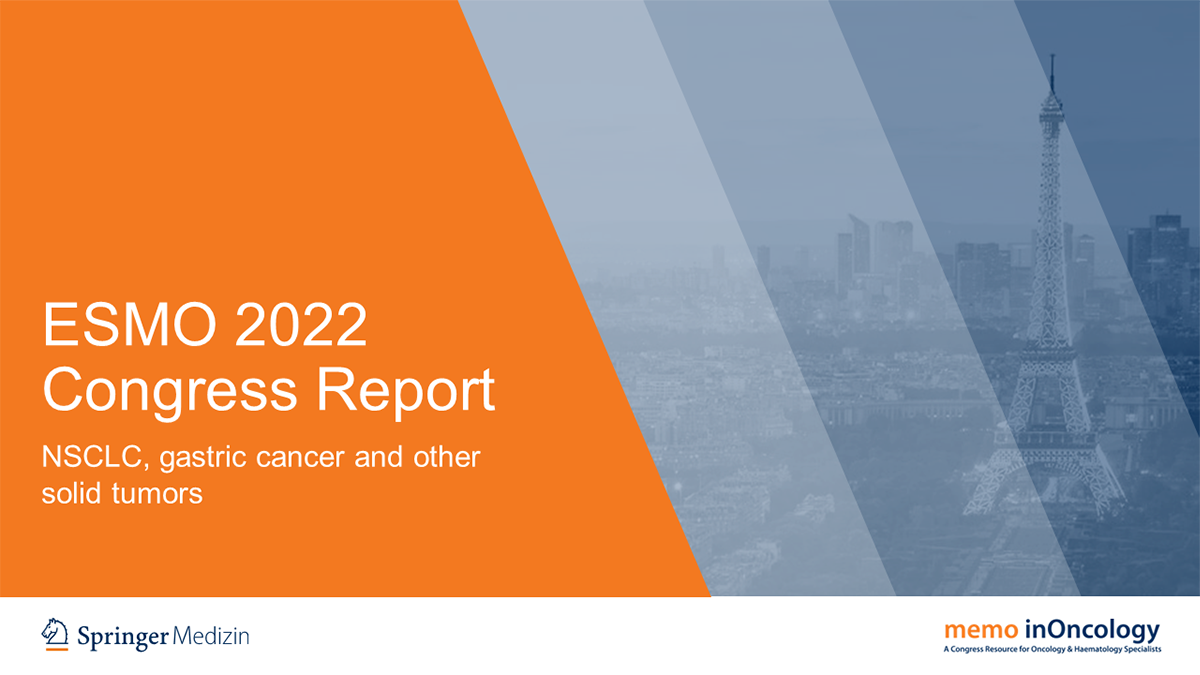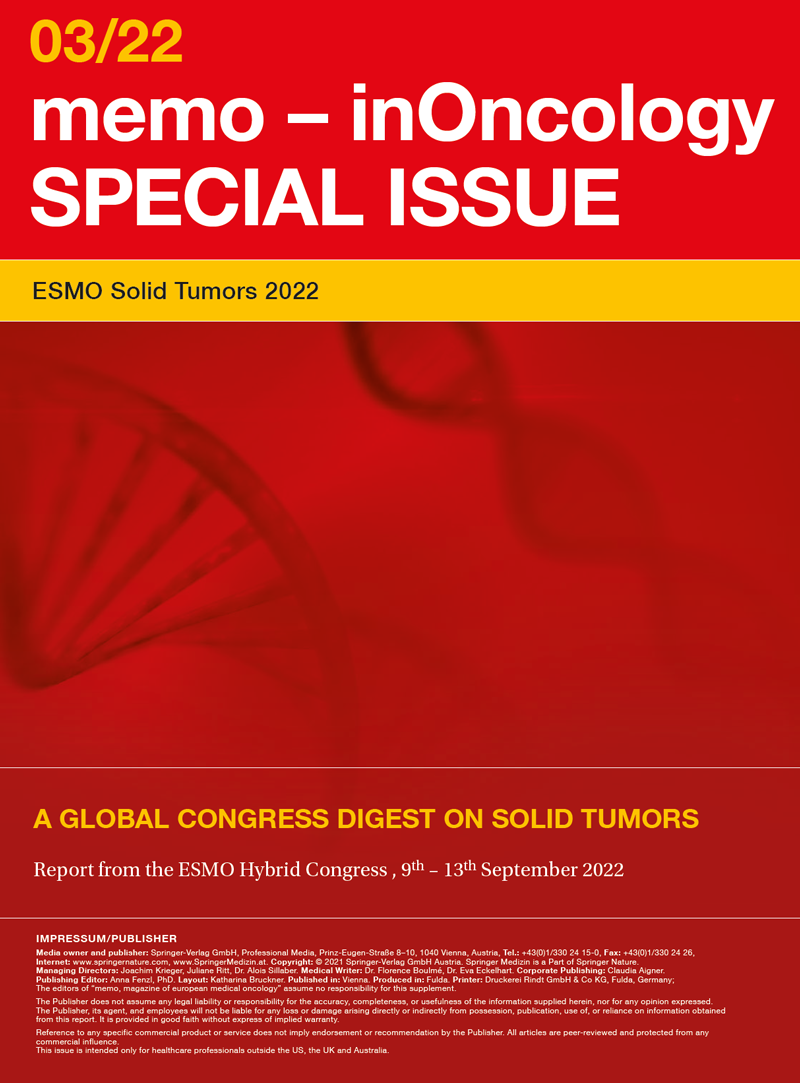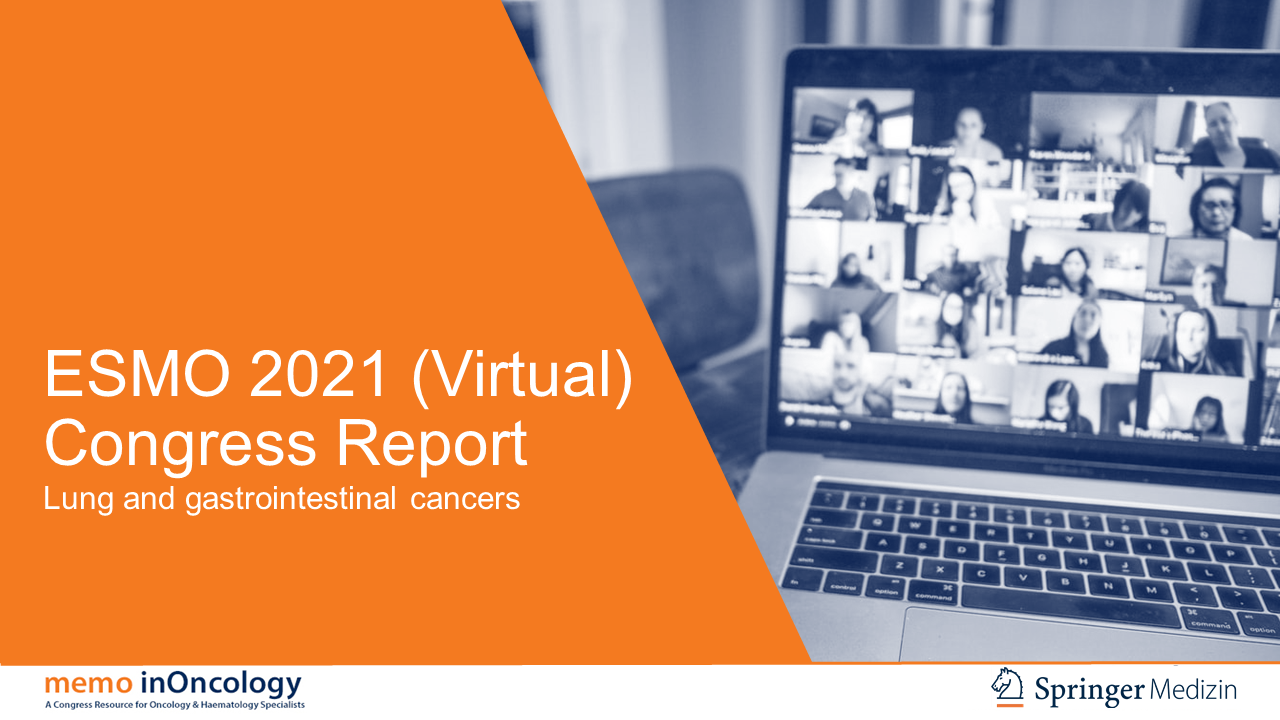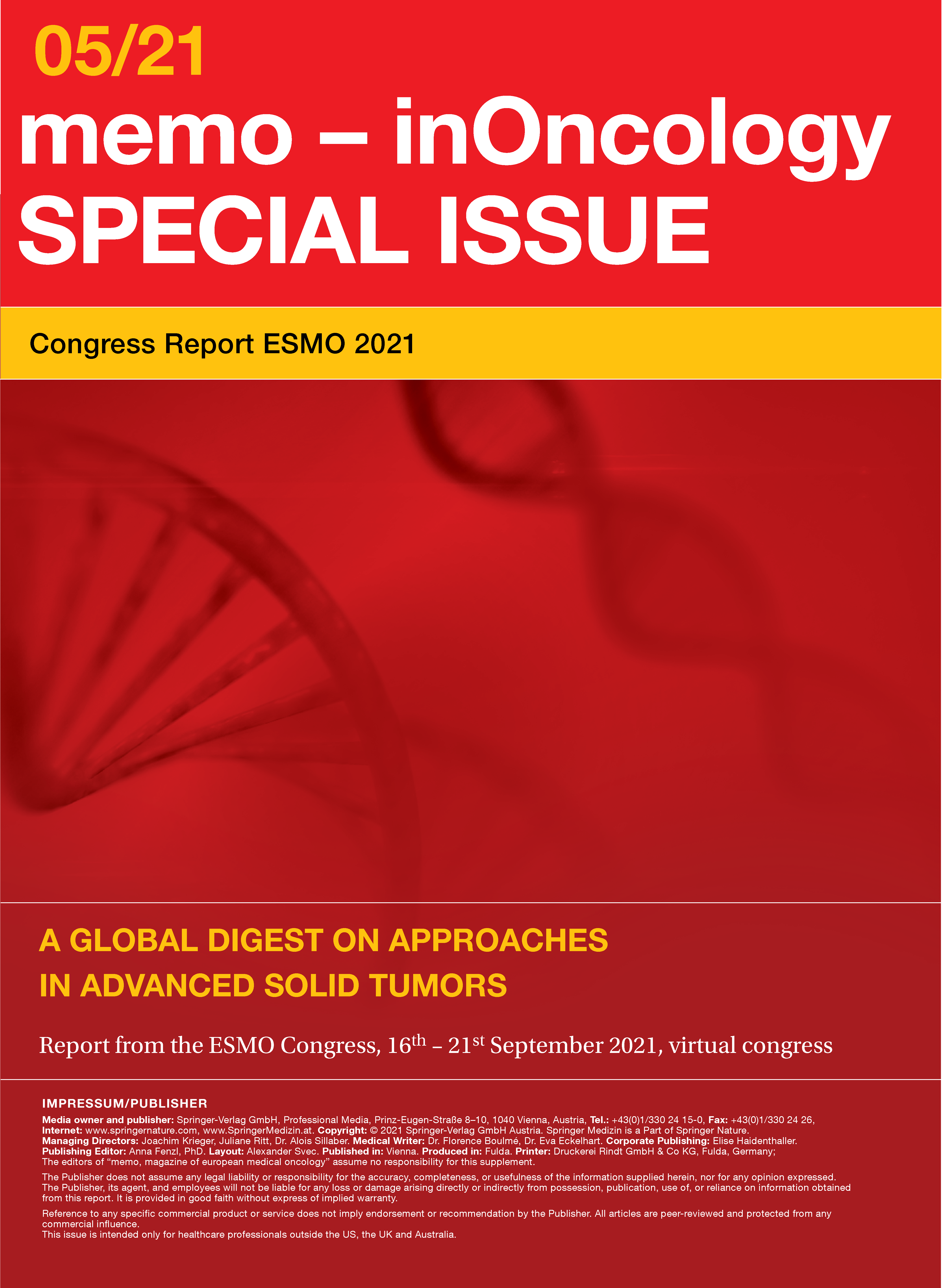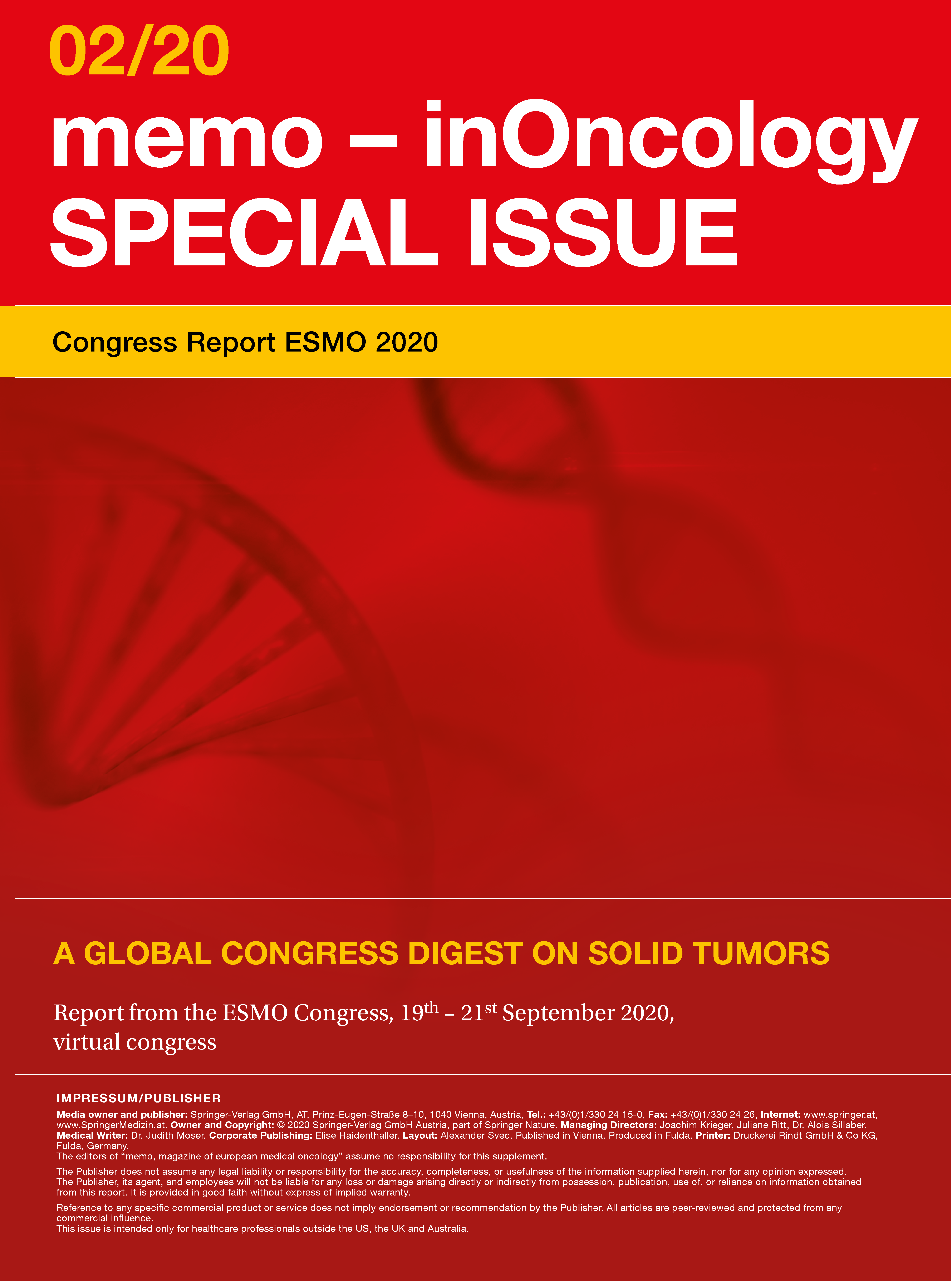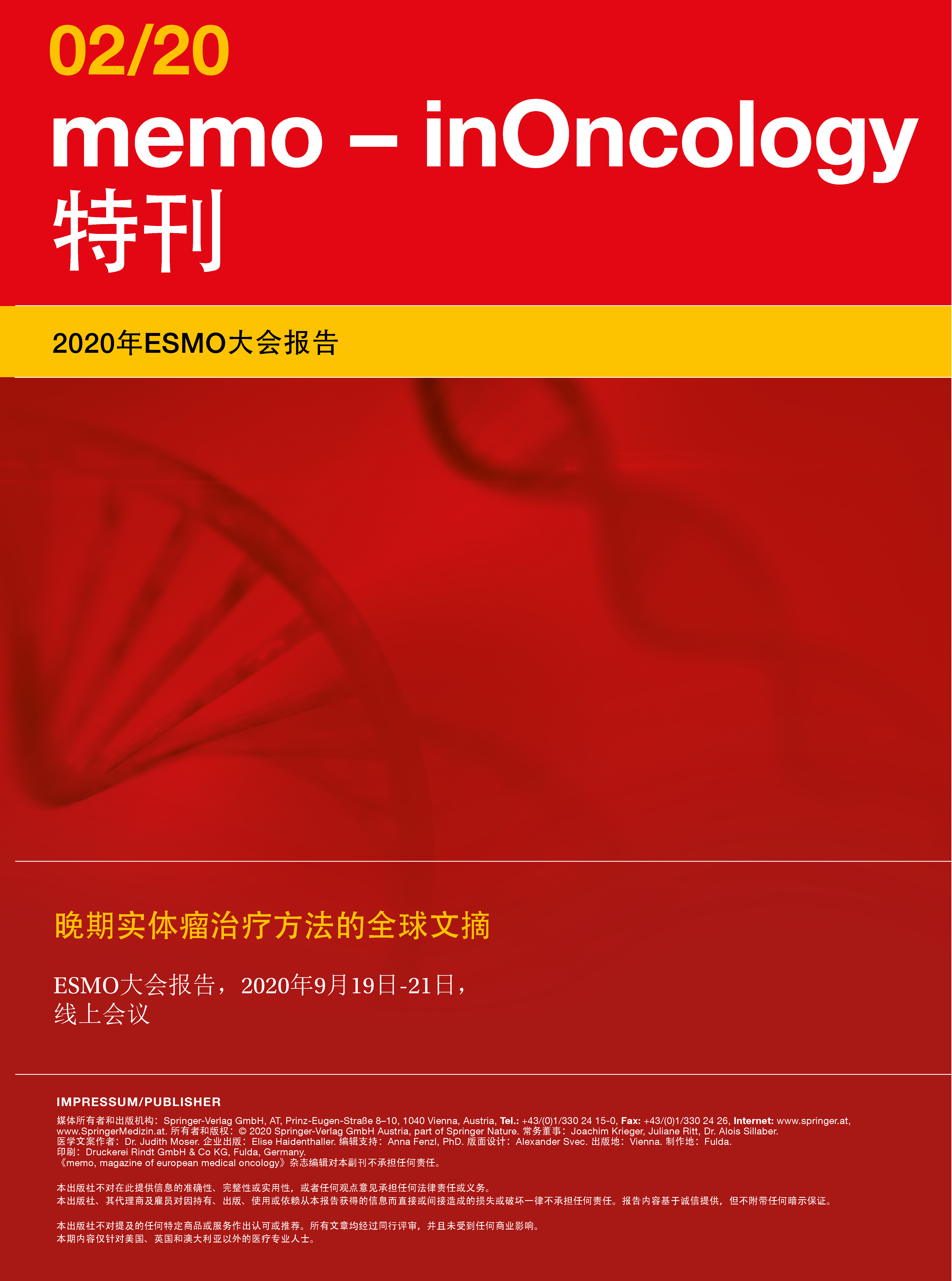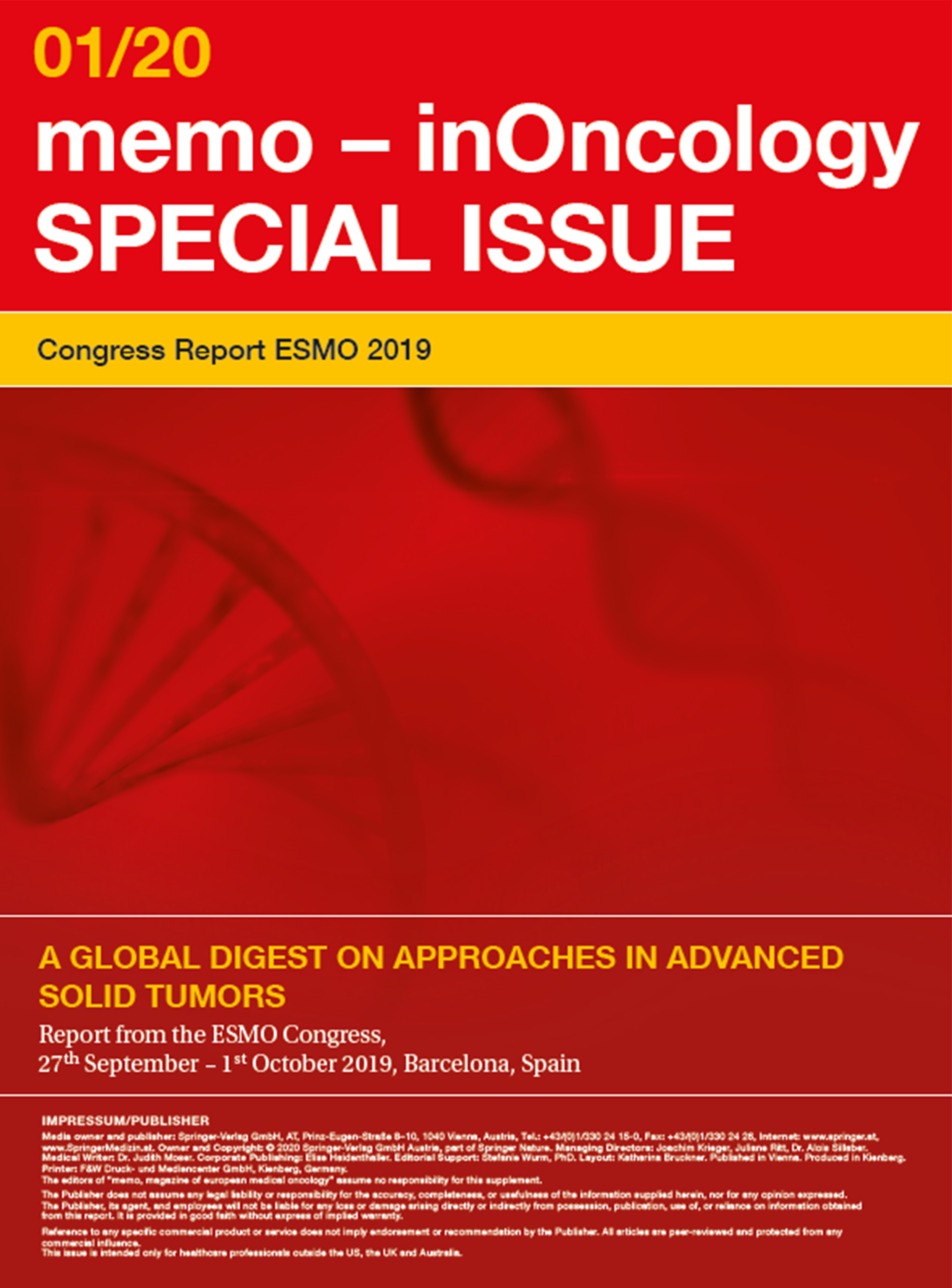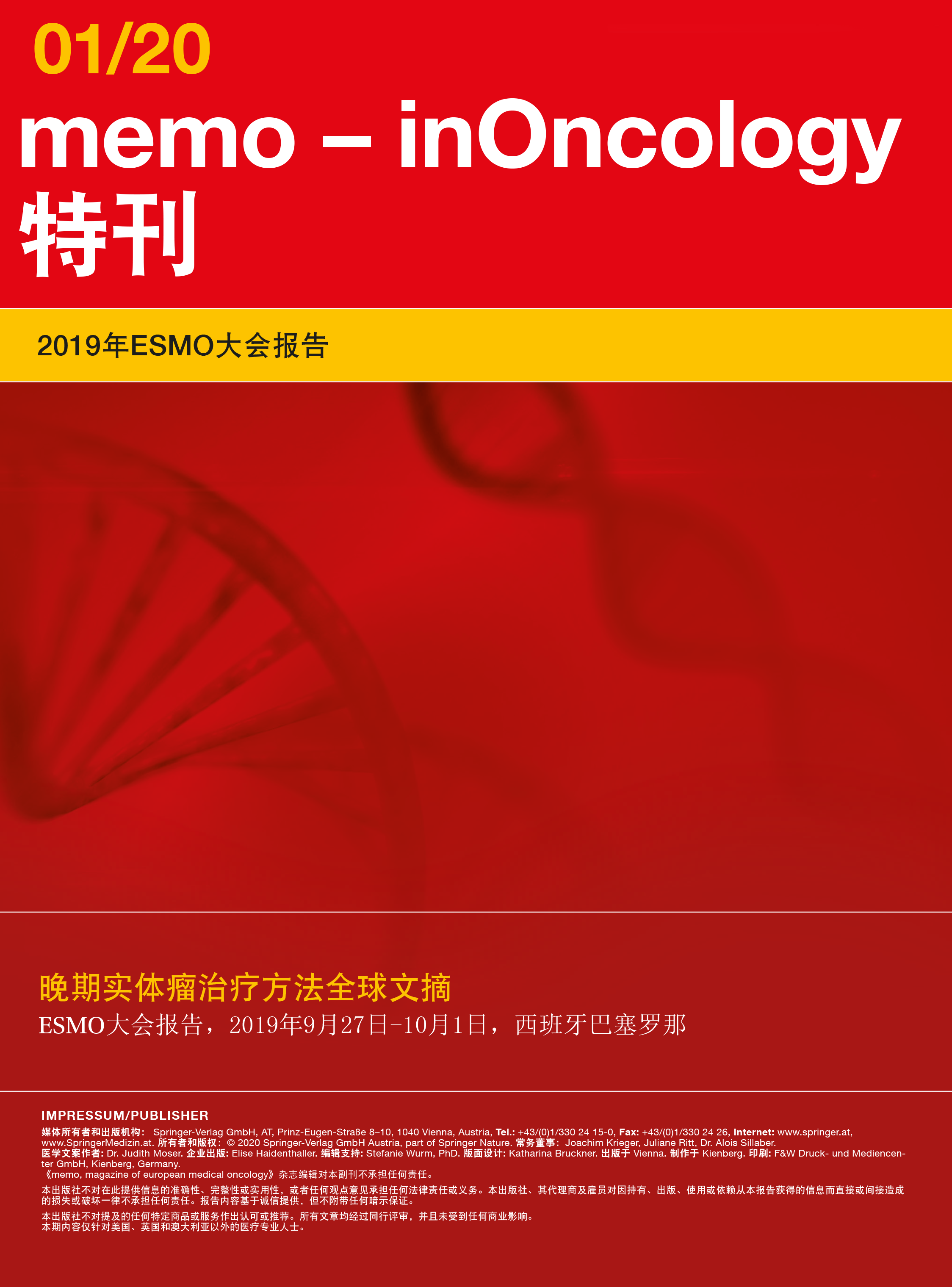ESMO 2022 – Solid Tumors – hybrid, Paris
Lecture Board: Myriam Chalabi, MD, PhD; Omid Hamid, MD; Jamie R. Merchan, MD; Armando Orlandi, MD, PhD; Matthias Pinter, MD, PhD
Medical Writer: Florence Boulmé, PhD; Eva Eckelhart, PhD
Publishing Editor: Anna Fenzl, PhD
Preface – ESMO Solid Tumor 2022
Preface – ESMO Solid Tumors 2022 © privat - Jaime R. Merchan, MD. MMSc, University of Miami Miller School of Medicine, Sylvester Comprehensive Cancer Center, Miami, USA Dear Colleagues, At the ESMO congress held in Paris, France, and virtually from 9th – 13th September 2022, practice-changing data and high-quality education attracted more than 29,300 participants from over 150 countries. The 1,912 abstracts reported at the conference included 76 late-breaking abstracts; among them, 11 abst
New clinical insights in head and neck squamous cell carcinoma
New clinical insights in head and neck squamous cell carcinoma Head and neck squamous cell carcinoma (HNSCC) was the sixth most common cancer in 2018, with more than 700,000 newly diagnosed cases per year and 350,000 cancer deaths worldwide [1]. Around 90 % of head and neck cancers are HNSCC, with oral cavity, oropharynx, hypopharynx, and larynx being the most commonly affected areas. The current standard of care (SOC) for locally advanced unresectable HNSCC is concurrent chemoradiotherapy (
Update on the treatment for advanced HCC
Update on the treatment for advanced HCC With more than 900,000 newly diagnosed cases in 2020, hepatocellular carcinoma (HCC) is the sixth most frequent malignant disease with a high mortality rate of approximately 92 % [1].
Towards treating all stages of gastric cancer and gastroesophageal junction adenocarcinoma
Towards treating all stages of gastric cancer and gastroesophageal junction adenocarcinoma Gastric and esophagus cancers were the fifth and the seventh most frequently diagnosed cancers worldwide in 2020, respectively.
From neoadjuvant to second-line therapeutic options for RCC patients
From neoadjuvant to second-line therapeutic options for RCC patients Kidney cancer accounted for more than 400,000 newly diagnosed cases in 2020, [1].
Promising therapeutic strategies for colorectal cancer treatment
Promising therapeutic strategies for colorectal cancer treatment With more than 1.9 million new cases, colorectal cancer (CRC) accounted in 2020 for 10 % of all diagnosed cancers. CRC ranked third in terms of incidence and was the second leading cause of cancer mortality worldwide, with 935,000 estimated deaths in 2020 [1].
Novel early clinical approaches in solid tumors
Novel early clinical approaches in solid tumors CLDN6 CAR-T cell therapy - Encouraging results Chimeric antigen receptor (CAR)-T cells have proven to be effective in the clinic for patients with malignant B-cell tumors but their application for solid tumors is challenging [1]. BNT211 is a novel therapeutic approach which comprises two components: CAR-T cells targeting the Claudin 6 (CLDN6) and a CLDN6-encoding CAR-T cell amplifying RNA vaccine (CARVac) [2]. On June 23, 2022, BNT211 has recei
EXPERT VIDEOS
All video interviews from ESMO Solid Tumors 2022
Stacey A. Cohen explains if ctDNA can detect MRD and predict recurrence in patients with colon cancer in a real-world setting, if it should be used in daily clinical practice or as a surveillance biomarker in stage II ctDNA-negative colon cancer patients. Moreover, she depicts how the treatment of patients with colon cancer might change in the foreseeable future.
ESMO 2021 – Solid Tumors – virtual
Lecture Board: Daniel Catenacci, MD; Chiara Cremolini, MD, PhD; Sara A. Hurvitz, MD; Krishnansu S. Tewari, MD; Romain Varnier, MD;
Medical Writer: Florence Boulmé, PhD; Eva Eckelhart, PhD
Publishing Editor: Anna Fenzl, PhD
Preface
Preface – ESMO 2021 Yelena Y. Janjigian, MD Memorial Sloan Kettering Cancer Center and Weill Cornell Medical College New York, NY, USA Dear Colleagues, For the second time, the ESMO scientific meeting took place virtually from 16th – 21st September 2021. Despite the challenges of the pandemic, the ESMO committee received an increased number of submitted abstracts compared to last year.
New horizons in colorectal cancer
New horizons in colorectal cancer FOLFIRINOX: real-world data in first line treatment Colorectal cancer (CRC) is the second leading cause of cancer death worldwide [1]
Colorectal cancer – personalized medicine for a heterogeneous disease
Colorectal cancer – personalized medicine for a heterogeneous disease Prof. Chiara Cremolini, MD, PhD., Department of Translational Research and New Technologies in Medicine and Surgery University of Pisa, Italy Metastatic colorectal cancer (mCRC), a major cause of death in the Western world, continuous to have a 5-year survival rate below 15 % [1], with microsatellite stable (MSS) mCRC representing the greatest clinical challenge due to its poorly characterized immune microenvironme
Novel approaches in gastric/gastroesophageal cancer
Novel approaches in gastric/gastroesophageal cancer Gastric cancer (GC) is the fifth most common cancer and the third leading cause of cancer death worldwide [1].
Highlights in cervical cancer
Highlights in cervical cancer In 2020, more than 600,000 new cases of cervical cancer were diagnosed. Its mortality rate reached 57 % with more than 340,000 deaths; cervical cancer was the ninth leading cause of cancer-related death worldwide and therefore a concerning global health issue.
Emerging landscape and treatment options in breast cancer
Emerging landscape and treatment options in breast cancer Breast cancer (BC) is the most common malignancy and the leading cause of cancer death worldwide in women; in 2020, almost 2.3 million people were diagnosed, and more than half a million died from BC [1].
EXPERT VIDEOS
All video interviews from ESMO Solid Tumors 2021
Yelena Y. Janjigian talks about the practice-changing results obtained in the CheckMate 649 trial and how the proportion of patients with advanced gastric cancer and esophageal adenocarcinoma who receive multiple treatment lines rather than just one or two can be increased. Biomarker-targeted therapies, precision medicine approaches for advanced G/GEJ cancers, the significance of chemotherapy as well as the duration of maintenance therapy are discussed, too.
Chiara Cremolini gives an overview of strategies that might become available in the future to enhance the efficacy of immunotherapies in the setting of microsatellite-stable metastatic colorectal cancer, how to increase the proportion of patients with metastatic colorectal cancer who receive multiple treatment lines, the optimal continuum of care in 2021 in metastatic colorectal cancer and how to predict progressive disease.
Javier Cortés highlights the superiority of trastuzumab deruxtecan compared to trastuzumab emtansine in patients with HER2-positive metastatic breast cancer and the resulting future therapy algorithm, potential combinations in the management of patients with HER2-negative breast cancer and the clinical relevance of immunotherapy-based approaches in the treatment of triple-negative breast cancer.
Ian Chau depicts the most interesting trial results in the field of esophageal cancer at the ESMO 2021 congress, gives an outlook on personalized approaches in the setting of esophageal squamous-cell carcinoma with regard to biomarkers for checkpoint inhibitors as well as potential further improvements of the prognosis of patients with esophageal cancer.
Ken Kato summarizes combination regimens currently investigated in the neoadjuvant treatment of patients with esophageal cancer and outlines how immunotherapy has changed the first-line treatment standards in patients with esophageal squamous-cell carcinoma and which further developments are expected for the first-and second-line setting in the future.
The ESMO congress has provided amazing new data on gastroesophageal cancer, and great contributions by different authors all over the world have been presented. Patients with advanced gastric cancer used to have a median overall survival of less than 1 year when treated with conventional chemotherapy. For the first time, this was prolonged to more than 1 year due to the addition of checkpoint inhibition.
ESMO 2020 – Solid Tumors – virtual
Lecture Board: Emiliano Calvo, MD, PhD; Andrés Cervantes, MD, PhD; Ronan Kelly, MD, MBA; Christian Schauer, MD
Medical Writer: Judith Moser, MD
Publishing Editor: Anna Fenzl, PhD
Preface – ESMO 2020 Solid Tumors
Preface – ESMO 2020 Solid Tumors Ronan Kelly, MD, MBA – Director of the Charles A. Sammons Cancer Center at Baylor University Medical Center – Dallas, Texas, USA Dear Colleagues, Notable advances that have been achieved in the treatment of solid tumors were discussed at the virtual ESMO Congress 2020, among them remarkable results obtained in the field of gastroesophageal tumors.
Milestones of PD-1 inhibition in gastric and esophageal cancer
Milestones of PD-1 inhibition in gastric and esophageal cancer Gastric cancer, gastroesophageal junction (GEJ) adenocarcinoma, and esophageal adenocarcinoma are substantial causes of cancer-related mortality worldwide and have poor 5-year overall survival (OS) when diagnosed at an advanced stage [1, 2].
Getting innovation from the laboratories into clinical practice
Getting innovation from the laboratories into clinical practice Andrés Cervantes, MD, PhD, Department of Medical Oncology, Hospital Clinic Universitario, Biomedical Research institute INCLIVA, University of Valencia, Spain Which data presented at ESMO 2020 in the field of gastric cancer, gastroesophageal junction adenocarcinoma and esophageal cancer do you deem practice-changing? The ESMO congress has provided amazing new data on gastroesophageal cancer, and great contributions by
Ovarian cancer: taking PARP inhibition one step further
Ovarian cancer: taking PARP inhibition one step further Individualized dosing of niraparib Niraparib has been approved as maintenance treatment for patients with platinum-sensitive recurrent ovarian cancer (OC) based on the results of the NOVA trial [1]. The starting dose used in NOVA was 300 mg orally daily.
Novel combination approaches in various solid tumors
Novel combination approaches in various solid tumors Lenvatinib plus pembrolizumab The anti-angiogenic multikinase inhibitor lenvatinib has been shown to exert immunomodulatory effects that enhance the anti-tumor activity of anti-PD-1 antibodies [1]. In the early-phase setting, lenvatinib plus pembrolizumab induced partial responses in patients with different tumor types [2].
序言
序言 Ronan Kelly, MD, MBA 美国德克萨斯州达拉斯 贝勒大学医学中心Charles A. Sammons癌症中心主任 亲爱的同事们, 2020年线上ESMO大会上讨论了在治疗实体瘤方面取得的显著进展,其中包括在胃食管肿瘤领域获得的引人注目的成果。对于患有转移性胃癌和食道癌的患者,长期结果仍然很差,并且最近几年进行的几项评估PD-(L)1抑制的临床试验显示出中等至阴性的结果。但是,免疫检查点抑制在这些难于治疗的肿瘤中的治疗作用已于2020年9月显现,2020线上ESMO举行的主席研讨会完全专注于可能改变临床实践的在可手术疾病的转移条件以及辅助条件(首次)下的III期试验。 与单独化疗相比,PD-1抑制剂纳武单抗(nivolumab)与化疗的组合在一线条件下进行的CheckMate 649和ATTRACTION-4研究中产生了改善的结果。对于晚期胃癌患者,传统上采用常规化疗治疗时的预期寿命不到一年,而在III期试验中首次将总生存期延长超过1年的界限。类似地,在食管癌中评价派姆单抗(pembrolizumab)加化疗的KEYNOTE-590试验显示出在多个终点方面
胃癌和食管癌中PD-1抑制取得的里程碑式进展
胃癌和食管癌中PD-1抑制取得的里程碑式进展 胃癌、胃食管连接部(GEJ)腺癌和食道腺癌是全球范围内与癌症相关死亡的重要原因,并且在晚期被诊断出时其5年总生存率(OS)较差[1, 2]。对于晚期或转移性HER2阴性胃癌和GEJ癌,标准一线化疗的中位OS不到1年[3-6]。
将创新从实验室带入临床实践
将创新从实验室带入临床实践 Andrés Cervantes, MD, PhD, 西班牙大学临床医院医学肿瘤学系, 生物医学研究所INCLIVA, 瓦伦西亚大学 您认为ESMO 2020在胃癌、胃食管连接部腺癌和食道癌领域介绍的哪些数据可能会改变实践? ESMO大会提供了胃食管癌方面令人惊喜的新数据,并介绍了世界各地不同作者的巨大贡献。
卵巢癌:将PARP抑制更进一步
卵巢癌:将PARP抑制更进一步 尼拉帕利(niraparib)的个性化用量 根据NOVA试验的结果,尼拉帕利已被批准作为铂敏感性复发性卵巢癌(OC)患者的维持治疗。
多种实体瘤中的新型组合方法
多种实体瘤中的新型组合方法 乐伐替尼(lenvatinib)加派姆单抗 抗血管生成多激酶抑制剂乐伐替尼已显示出发挥免疫调节作用,增强抗PD-1抗体的抗肿瘤活性[1]。
EXPERT VIDEOS
All video interviews from ESMO Solid Tumors 2020
Andrés Cervantes talks about novel findings obtained in the field of gastric cancer, gastroesophageal junction adenocarcinoma and esophageal cancer as well as developments in hepatocellular carcinoma and investigational immunotherapies that might evolve into new treatment approaches.
Eric Van Cutsem gives an overview of practice-changing results obtained for gastrointestinal cancers including colorectal cancer, gastric cancer and esophageal cancer and describes progress that has recently been made with respect to certain biomarkers.
The ESMO congress has provided amazing new data on gastroesophageal cancer, and great contributions by different authors all over the world have been presented. Patients with advanced gastric cancer used to have a median overall survival of less than 1 year when treated with conventional chemotherapy. For the first time, this was prolonged to more than 1 year due to the addition of checkpoint inhibition.
ESMO 2019 – Solid Tumors – Barcelona
Lecture Board: Hendrik-Tobias Arkenau, MD, PhD; Nicoletta Colombo, MD; Pascal Hammel, MD; Maha Hussain, MD; Paolo Nuciforo, MD, PhD; Bertrand Routy, MD, PhD; Gert Schachtner, MD; Christian Schauer, MD; Agostina Stradella, MD
Medical Writer: Dr. Judith Moser
Preface
Preface Dear readers, With “memo inOncology” Springer has created a medical education platform that is globally accessible and offers value to health care professionals in oncology (www.memoinoncology.com).
PD-1 inhibition in gastric and esophageal cancer, hepatocellular carcinoma, and urothelial carcinoma
PD-1 inhibition in gastric and esophageal cancer, hepatocellular carcinoma, and urothelial carcinoma Gastric and esophageal cancer Adenocarcinoma of the stomach and gastroesophageal junction (GEJ) ranks fifth among the most common malignancies worldwide [1, 2] and is the third leading cause of cancer-related death in both sexes [3].
Potential role of the microbiome in carcinogenesis and response to checkpoint inhibition
Potential role of the microbiome in carcinogenesis and response to checkpoint inhibition Bacteria are of eminent importance for health and the functioning of the human body that contains more bacterial than human cells, at a ratio of 1.3 to 1 [1, 2]. More than 10,000 different microbe species have been identified in the body.
PARP inhibition in gynecological cancers: recent insights
PARP inhibition in gynecological cancers: recent insights Poly(ADP-ribose) polymerase (PARP) inhibitors have been established as an important drug class for the treatment of advanced ovarian cancer (OC), which is a leading cause of cancer deaths in women.
New applications of PARP inhibitors
New applications of PARP inhibitors Metastatic castration-resistant prostate cancer Metastatic castration-resistant prostate cancer (mCRPC) that progresses after androgen-receptor(AR)–targeted therapy (i.e., enzalutamide or abiraterone) and taxane-based chemotherapy is associated with a poor prognosis [1].
Increasing PARP inhibitor activity via several mechanisms of action
Increasing PARP inhibitor activity via several mechanisms of action Hendrik-Tobias Arkenau, MD, PhD, FRCP, Sarah Cannon Research Institute, London, UK What is your take-home message from ESMO 2019 in relation to the use of PARP inhibitors in solid tumors? Several studies showing favorable results with PARP inhibitors have been reported at this year’s ESMO Congress. In particular, the results of the PAOLA study can be considered a major breakthrough [1].
序言
序言 亲爱的读者们, 借助“memo inOncology”,施普林格创建了一个能够全球访问的医学教育平台,向肿瘤学领域的医疗保健专业人士提供有价值的内容(www.memoinoncology. com)。在过去的四年中,我们报道了ASCO、ESMO、WCLC、ELCC或ESMO Asia等重大会议在肺癌领域的最新内容荟萃。我们的大会报告及其中文和日文译本在国际上受到了极大关注。因此,我们决定在该成功的基础上进行积极扩充,创建有关其他实体瘤的更多内容。本期内容涵盖有关抗PD-1治疗的新型
胃癌和食管癌、肝细胞癌以及尿路上皮癌中的PD-1抑制
胃癌和食管癌、肝细胞癌以及尿路上皮癌中的PD-1抑制 胃癌和食管癌 胃和胃食管交界处(GEJ)发生的腺癌在全球最常见的恶性肿瘤中排名第五[1, 2],在男性和女性中均为癌症相关死亡的第三大主要原因[3]。由于该疾病无早期症状的特征,因此大多数患者在晚期才得以诊断。尽管全球发病率下降且治疗取得显著进展,仍需进一步努力来改善预后[4]。 食管癌在全球最常见的癌症中排名第七[5]。2018年,食管癌在中国所有癌症类型中发病率排名第五,死亡率排名第四[6]。最常见的亚型是鳞状细胞癌(SCC)和腺
微生物组在癌变和对检查点抑制的应答中的潜在作用
微生物组在癌变和对检查点抑制的应答中的潜在作用 细菌对于人体的健康和功能具有至关重要的作用,人体含有的细菌比人体细胞更多,比例为1.3:1 [1, 2]。人体内已鉴定出超过10,000种不同的微生物物种。每个人都携带10至100万亿个共生微生物细胞,这些微生物主要在肠道中。它们的基因数量超过人类基因组的基因数量,比例大致为100:1。肠道微生物组完成了许多与免疫系统的代谢和调节有关的重要任务(表)[3]。 在这里,生态失调的概念开始发挥作用,该概念是指宿主的共生微生物生态系统从健康相关的
妇科癌症中的PARP抑制:最新见解
妇科癌症中的PARP抑制:最新见解 聚(ADP-核糖)聚合酶(PARP)抑制剂已被确定为治疗晚期卵巢癌(OC)的重要药物类别,而晚期卵巢癌是女性癌症死亡的主要原因。奥拉帕尼(olaparib)和尼拉帕尼(niraparib)已被广泛批准用于对铂类化疗有应答的OC患者的维持治疗。在2019年ESMO大会上介绍的数据提供了有关在早期线中以及与其他药物类别组合使用PARP抑制的信息。此外,用维利帕尼(veliparib)进行的研究表明,该PARP抑制剂与化疗可在卵巢癌和乳腺癌中联合使用。 BA
PARP抑制剂的新应用
PARP抑制剂的新应用 转移性去势抵抗性前列腺癌 在雄激素受体(AR)靶向治疗(即恩杂鲁胺(enzalutamide)或阿比特龙(abiraterone))和紫杉烷类化疗后发生进展的转移性去势抵抗性前列腺癌(mCRPC)与预后不良相关联[1]。这些患者仅有很少的治疗选择。高达25 %的mCRPC男性在BRCA1、BRCA2、ATM或其他DNA损伤修复(DDR)基因中携带有害的种系和/或体细胞改变,包括在同源重组修复(HRR)中具有直接或间接作用的那些[2-4] 。这些改变与对PARP抑制
通过多种作用机制提高PARP抑制剂活性
通过多种作用机制提高PARP抑制剂活性 Hendrik-Tobias Arkenau,MD,PhD,FRCP,英国伦敦萨拉•坎农研究所 关于在实体瘤中使用PARP抑制剂,您从2019年ESMO大会中获得了哪些键信息? 在本年度ESMO大会上报告了若干项研究,显示使用PARP抑制剂获得了有利结果。特别是,PAOLA研究的结果可以认为是一项重大突破[1]。一线化疗后在卵巢癌患者的贝伐珠单抗维持治疗之外添加奥拉帕尼不仅在BRCA突变肿瘤患者中带来无进展生存期改善,而且在BRCA野生型患者中也
EXPERT VIDEOS
All video interviews from ESMO 2019
Hendrik-Tobias Arkenau discusses combination studies of novel PARP inhibitors with other drugs.
Florian Lordick on the use of anti-PD-1 and other emerging therapies in gastric and oesophageal cancers.
Markus Möhler presents novel findings on anti-PD-1 therapies and explains differences regarding the outcome of anti-PD-1 therapies in Asian and Caucasian populations.
Simon Chowdhury talks about the use of PARP inhibitors in prostate cancer as well as the impact of pamiparib in patients with advanced solid tumors.
Over the last four years, we have reported from major conferences such as ASCO, ESMO, WCLC, ELCC or ESMO Asia on recent highlights in the field of lung cancer. Our congress reports and translations thereof into Mandarin and Japanese have received great international interest.


